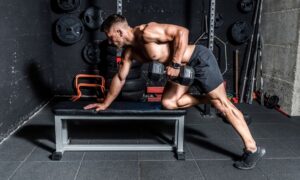In the realm of fitness, functional training has gained significant popularity in recent years, and for good reason. Unlike traditional gym workouts that often focus on isolated muscle groups and aesthetic goals, functional fitness emphasizes movements that mimic real-life activities and improve overall functionality and mobility. By incorporating functional exercises into your workout routine, you can enhance everyday movement patterns, reduce the risk of injury, and improve your quality of life. Let’s delve into the concept of functional fitness and explore how it can benefit people of all ages and fitness levels.
- Understanding Functional Fitness
Functional fitness is a training approach that focuses on exercises and movements that replicate and enhance everyday activities. Rather than isolating individual muscles, functional exercises engage multiple muscle groups and joints simultaneously, promoting better coordination, balance, and flexibility. The goal of functional fitness is to improve overall movement patterns, strength, and mobility, enabling individuals to perform daily tasks more efficiently and with less risk of injury. - Benefits of Functional Fitness
The benefits of functional fitness extend beyond the gym, impacting various aspects of daily life. Some key advantages include:
⦁ Improved Movement Quality: Functional exercises train the body to move in a more natural and coordinated manner, enhancing overall movement quality and efficiency.
⦁ Increased Strength and Stability: By engaging multiple muscle groups and joints, functional exercises build strength and stability that translates to better performance in everyday activities.
⦁ Enhanced Balance and Coordination: Functional exercises challenge balance and coordination, helping to improve proprioception and reduce the risk of falls, especially in older adults.
⦁ Injury Prevention: Functional fitness focuses on movements that mimic real-life activities, helping to strengthen muscles and joints in a way that reduces the risk of injury during daily tasks or sports activities.
⦁ Greater Flexibility and Range of Motion: Functional exercises promote flexibility and mobility, allowing for a greater range of motion in everyday movements and activities. - Key Principles of Functional Fitness
Functional fitness programming is guided by several key principles that inform exercise selection and progression:
⦁ Multi-Planar Movement: Functional exercises involve movements in multiple planes of motion (e.g., sagittal, frontal, transverse), allowing for greater versatility and functionality.
⦁ Integration of Core Stability: Core stability is emphasized in functional fitness, as a strong core is essential for maintaining proper posture, balance, and alignment during movement.
⦁ Movement Patterns, Not Muscles: Functional exercises focus on movement patterns rather than isolated muscle groups, training the body to work as a cohesive unit.
⦁ Progression and Variation: Functional fitness programs incorporate progression and variation to continually challenge the body and prevent plateaus in performance. - Examples of Functional Exercises
Functional exercises can be performed using bodyweight, resistance bands, free weights, or functional training equipment like stability balls, medicine balls, and kettlebells. Some examples of functional exercises include:
⦁ Squats: A fundamental lower body exercise that improves leg strength, balance, and mobility.
⦁ Lunges: A unilateral lower body exercise that targets the quadriceps, hamstrings, glutes, and calves while improving balance and stability.
⦁ Push-Ups: An upper body exercise that strengthens the chest, shoulders, triceps, and core muscles.
⦁ Deadlifts: A compound exercise that targets the posterior chain (lower back, glutes, hamstrings) while improving hip mobility and stability.
⦁ Planks: A core-strengthening exercise that also engages the shoulders, chest, and back muscles.
⦁ Farmer’s Walks: A functional exercise that involves walking while holding heavy weights (e.g., dumbbells or kettlebells), improving grip strength, core stability, and overall strength. - Incorporating Functional Fitness into Your Routine
Whether you’re new to exercise or a seasoned fitness enthusiast, incorporating functional fitness into your routine is relatively straightforward. Start by focusing on movements that mimic activities you perform regularly, such as squatting, bending, pushing, pulling, and rotating. Gradually progress by increasing the intensity, complexity, and resistance of your exercises over time. Consider working with a certified personal trainer or fitness professional to design a personalized functional fitness program tailored to your goals and fitness level. - Conclusion
Functional fitness offers a holistic approach to improving movement quality, strength, stability, and mobility, making it a valuable addition to any fitness regimen. By incorporating functional exercises into your routine, you can enhance everyday movement patterns, reduce the risk of injury, and improve your overall quality of life. Whether you’re aiming to perform better in sports and recreational activities, maintain independence as you age, or simply move with more ease and efficiency, functional fitness provides the tools and principles to help you achieve your goals effectively and sustainably.





